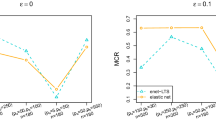Abstract
In this paper, we developed a sparse Bayesian variable selection in kernel probit model for high-dimensional data classification. Particularly we assigned a correlation prior distribution on the model size and a sparse prior distribution on the regression parameters. MCMC-based computation algorithms are outlined to generate samples from the posterior distributions. Simulation and real data studies show that in terms of the accuracy of variable selection and classification, our proposed method performs better than the other five Bayesian methods without the correlation term in the prior or those involving only one shrinkage parameter.
Similar content being viewed by others
References
Albert J, Chib S (1993) Bayesian analysis of binary and polychotomous response data. J Am Stat Assoc 88:669–679
Alon U, Barkai N, Notterman DA, Gish K, Ybarra S, Mack D, Levine AJ (1999) Broad patterns of gene expression revealed by clustering analysis of tumor and normal colon tissues probed by oligonucleotide arrays. Proc Natl Acad Sci 96:6745–6750
Araki T, Ikeda K, Akaho S (2015) An efficient sampling algorithm with adaptations for Bayesian variable selection. Neural Netw 61:22–31
Armagan A, Dunson DB, Lee J (2013) Generalized double Pareto shrinkage. Statistica Sinica 3(1):119–143
Ben-Dor A et al (2000) Tissue classification with gene expression profiles. J Comput Biol 7:559–583
Bradley P, Mangasarian O (1998) Feature selection via concave minimization and support vector machines. In: Proceedings of the 15th international conference on machine learning, pp 82–90
Chakraborty S, Mallick BK, Ghosh M (2013) Bayesian hierarchical kernel machines for nonlinear regression and classification. In: Damien P, Dellaportas P, Polson NG, Stephens DA (eds) Bayesian theory and applications (A tribute to Sir Adrian Smith). Oxford University Press, Oxford, pp 50–69
Chhikara R, Folks L (1989) The inverse gaussian distribution: theory, methodology and applications. Marcel Dekker, New York
Crawford L, Wood KC, Zhou X, Mukherjee S (2017) Bayesian approximate kernel regression with variable selection. J Am Stat Assoc 113:1710–1721. https://doi.org/10.1080/01621459.2017.1361830
Dettling M (2004) BagBoosting for tumor classification with gene expression data. Bioinformatics 20:3583–3593
Devroye L (1986) Non-uniform random variate generation. Springer, New York
Dougherty ER (2001) Small sample issues for microarray-based classification. Comp Funct Genom 2:28–34
George EI, McCulloch RE (1993) Variable selection via Gibbs sampling. J Am Stat Assoc 88:881–889
Gelfand A, Smith AFM (1990) Sampling based approaches to calculating marginal densities. J Am Stat Assoc 85:398–409
Golub TR et al (1999) Molecular classification of cancer:class discovery and class prediction by gene expression monitoring. Science 286:531–537
Guyon I, Weston J, Barnhill S, Vapnik V et al (2002) Gene selection for cancer classification using support vector machines. Mach Learn 46:389–422
Lamnisos D, Grin JE, Mark Steel FJ (2009) Transdimensional sampling algorithms for Bayesian variable selection in classification problems with many more variables than observations. J Comput Gr Stat 18:592–612
Lee KE et al (2003) Gene selection: a Bayesian variable selection approach. Bioinformatics 19:90–97
Mallick BK, Ghosh D, Ghosh M (2005) Bayesian classification of tumors using gene expression data. J R Stat Soc B 67:219–232
Metropolis N, Rosenbluth AW, Rosenbluth MN, Teller AH, Teller E (1953) Equations of state calculations by fast computing machines. J Chem Phys 21:1087–1092
Notterman D et al (2001) Transcriptional gene expression profiles of colorectal adenoma, adenocarcinoma, and normal tissue examined by oligonucleotidearrays. Cancer Res 61:3124–3130
Panagiotelisa A, Smith M (2008) Bayesian identification, selection and estimation of semiparametric functions in high dimensional additive models. J Econom 143:291–316
Park K, Casella G (2008) The Bayesian lasso. J Am Stat Assoc 103:681–686
Shailubhai K et al (2000) Uroguanylin treatment suppresses polyp formation in the Apc(Min/+) mouse and induces apoptosis in human colon adenocarcinoma cells via cyclic GMP. Cancer Res 60:5151–5157
Tolosi L, Lengauer T (2011) Classification with correlated features: unreliability of feature ranking and solutions. Bioinformatics 27:1986–1994
Troyanskaya OG et al (2002) Nonparametric methods for identifying differentially expressed genes in microarray data. Bioinformatics 18:1454–1461
Vapnik VN (1995) The nature of statistical learning theory. Springer, New York
Wahba G (1990) Spline models for observational data. SIAM, Philadelphia
Wang L, Zhu J, Zou H (2008) Hybrid huberized support vector machines for microarray classification and gene selection. Bioinformatics 24:412–419
Yang AJ, Xiang J, Yang HQ, Lin JG (2018a) Sparse Bayesian variable selection in probit model for forecasting U.S. recessions using a large set of predictors. Comput Econ 51:1123–1138
Yang AJ, Jiang XJ, Shu LJ, Liu PF (2018b) Sparse bayesian kernel multinomial probit regression model for high-dimensional data classification. Commun Stat-Theory Methods 48:165–176. https://doi.org/10.1080/03610926.2018.1463385
Yang AJ, Xiang J, Shu LJ, Yang HQ (2018c) Sparse bayesian variable selection with correlation prior for forecasting macroeconomic variable using highly correlated predictors. Comput Econ 51:323–338
Yuan M, Lin Y (2005) Efficient empirical Bayes variable selection and estimation in linear models. J Am Stat Assoc 472:1215–1225
Zhang Z, Dai G, Jordan MI (2011) Bayesian generalized kernel mixed models. J Mach Learn Res 12:111–139
Zhou X, Wang X, Wong S (2004a) A Bayesian approach to nonlinear probit gene selection and classification. J Frankl Inst 341:137–156
Zhou X, Liu K, Wong S (2004b) Cancer classification and prediction using logistic regression with Bayesian gene selection. J Biomed Inf 37:249–259
Acknowledgements
The authors gratefully acknowledge the financial support of the Humanities and Social Science Foundation of Ministry of Education of China (18YJC910001), the Natural Science Foundation of China (11501294,11501167,11571073), the University Philosophy and Social Science Research Project of Jiangsu Province (2018SJA0130) and the Jiangsu Qinglan Project(2017).
Author information
Authors and Affiliations
Corresponding author
Ethics declarations
Conflict of interest
On behalf of all authors, the corresponding author states that there is no conflict of interest
Additional information
Publisher's Note
Springer Nature remains neutral with regard to jurisdictional claims in published maps and institutional affiliations.
Rights and permissions
About this article
Cite this article
Yang, A., Tian, Y., Li, Y. et al. Sparse Bayesian variable selection in kernel probit model for analyzing high-dimensional data. Comput Stat 35, 245–258 (2020). https://doi.org/10.1007/s00180-019-00917-8
Received:
Accepted:
Published:
Issue Date:
DOI: https://doi.org/10.1007/s00180-019-00917-8




